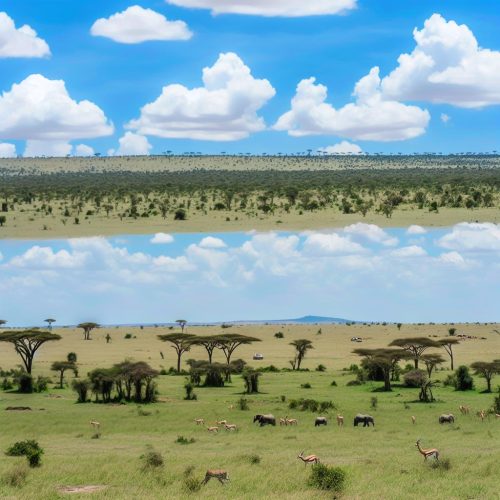Lewa Wildlife Conservancy Overview
The Lewa Wildlife Conservancy is a significant conservation area nestled in the picturesque landscapes at the foothills of Mount Kenya. Spanning approximately 250 square kilometers, this conservancy is a critical player in wildlife preservation and community development efforts. Recognized for its innovative conservation strategies, Lewa strikes a balance between animal protection and addressing the needs of adjoining communities. More than just a safe haven for wildlife, it serves as a model for sustainable conservation practices worldwide.
History and Establishment
The roots of the Lewa Wildlife Conservancy trace back to its founding in 1995. Originally a cattle ranch, it was repurposed into a dedicated wildlife sanctuary. The founders’ vision was to tackle the pressing issues of poaching and the need to safeguard endangered species, with a particular focus on the black rhino. Over the years, Lewa has evolved into a pioneering entity in sustainable conservation, demonstrating a commitment that goes beyond mere preservation.
Conservation Efforts
The Lewa Wildlife Conservancy has made significant strides in providing sanctuary to a myriad of endangered species. Its concerted efforts have notably led to substantial increases in the populations of both black and white rhinos. Additionally, the conservancy plays an instrumental role in protecting the Grevy’s zebra, ensuring these majestic creatures continue to thrive. Employing a multifaceted approach to conservation, Lewa integrates anti-poaching initiatives, habitat restoration, and community engagement into its strategies. These efforts collectively contribute to the sustainable survival and growth of these species. To learn more about Lewa’s ongoing projects and conservation strategies, you can visit their official website.
Community Engagement
An essential aspect of Lewa’s conservation philosophy is the recognition that successful conservation is intricately linked with the well-being of local communities. Lewa actively involves these communities in its operations, providing not just employment opportunities, but also education and healthcare initiatives. By investing in community welfare, the conservancy fosters a harmonious coexistence between people and wildlife. Its community-oriented projects are diverse, encompassing infrastructure development, educational scholarships, and accessible health services, thereby enhancing the quality of life for those living in the surrounding areas.
Visit and Explore
For visitors, the Lewa Wildlife Conservancy offers an unparalleled opportunity to experience wildlife in its natural, untouched habitat. Through carefully guided tours and safaris, guests can witness a splendid array of wildlife, from the elusive black rhino to vibrant bird species. The conservancy prioritizes sustainable tourism practices, ensuring that the natural environment is left undisturbed for future generations to appreciate. Thus, each visit to Lewa is not only a chance to indulge in the beauty of nature but also a step towards supporting the ongoing conservation efforts.
In conclusion, the Lewa Wildlife Conservancy exemplifies the integration of effective conservation methods with proactive community development. Its accomplishments serve as an inspiration for similar initiatives globally, vividly demonstrating the significant impact well-orchestrated conservation programs can have. From its origins rooted in the reformation of a cattle ranch to its standing today as a pivotal conservation entity, Lewa continues to forge a path forward, illustrating that with dedication and innovation, both wildlife and human communities can flourish together.
Lewa’s Broader Impact
The influence of the Lewa Wildlife Conservancy extends beyond its immediate geographic location. By setting a benchmark in conservation practices, Lewa has had a transformative effect on conservation strategies across the world. Its model is increasingly being adopted by other conservancies that seek to emulate its success. Moreover, Lewa contributes to global conversations on conservation, sharing insights and learnings that have the potential to guide efforts in other regions, perhaps even those struggling with similar environmental challenges.
Research and Development
Research and development form a cornerstone of Lewa’s operations. The conservancy is a hub for scientific research, hosting local and international researchers who study various aspects of wildlife management and environmental conservation. The knowledge garnered here not only informs Lewa’s conservation strategies but also enriches the global scientific community. Research efforts focus on understanding animal behavior, ecosystem dynamics, and the impacts of climate change on native habitats, thereby fostering a deeper comprehension of the complex interdependencies in natural ecosystems.
Education and Awareness
Another vital component of Lewa’s work is education and awareness. By actively engaging with schools and educational institutions, the conservancy promotes a deeper understanding of conservation issues among the younger generation. Educational programs are designed to inspire and empower students, turning them into champions for wildlife and conservation. Furthermore, Lewa organizes awareness campaigns aimed at educating the broader public about the importance of conservation, not just within the confines of the conservancy but on a global scale as well.
The journey of the Lewa Wildlife Conservancy is a striking example of how strategic conservation can yield profound benefits. Through continuous innovation, Lewa demonstrates that safeguard ecosystems and nurturing human communities go hand in hand. Its story is not just about preserving the past, but about shaping a sustainable future where humans and wildlife thrive together.
